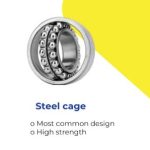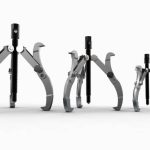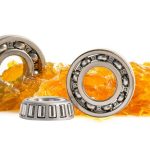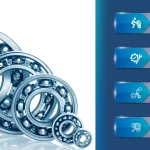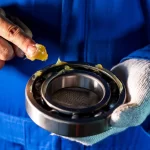In the complex domain of automotive engineering, specific components work silently to guarantee smooth vehicle functionality. Among these essential contributors, wheel bearings play a crucial role in ensuring efficiency and safety.
What is Wheel Bearing?
A wheel bearing, at its core, is a compact yet critical component that facilitates the smooth rotation of the wheel hub assembly. This unassuming element bears the weight of the vehicle while ensuring minimal friction for optimal performance. Comprising an inner and outer ring, rolling elements (balls or rollers), and a cage to retain these elements, a wheel bearing is a precision-engineered assembly designed for reliability.
Components of Wheel Bearings
- Inner and Outer Ring: These rings form the structural framework of the bearing, providing support and stability for operation.
- Rolling Elements (Balls or Rollers): Positioned between the inner and outer rings, these are the actual components responsible for enabling smooth rotation. Depending on the design and specific application, wheel bearings can feature either balls or rollers as their rolling elements.
- Cage: The rolling elements are housed and separated by a cage, which serves to retain them in their proper positions. The cage maintains the spacing between the rolling elements and prevents any unwanted friction or interference by providing smooth movability.
This precision-engineered assembly is designed with meticulous attention to detail, considering factors such as load-bearing capacity, durability, and operational efficiency. The synergy of these components allows wheel bearings to withstand the demands of vehicular motion while providing reliable and consistent performance.
Types of Wheel Bearings
- Ball Bearings: In the realm of wheel bearings, ball bearings employ spherical balls to facilitate smooth rolling between the inner and outer raceways. This design is prevalent due to its efficiency and versatility.
- Roller Bearings: With cylindrical or tapered rollers distributing the load evenly, roller bearings are preferred for applications demanding durability and resilience, especially in heavy-duty scenarios.
- Tapered Roller Bearings: Exhibiting versatility by handling both radial and axial loads, tapered roller bearings are commonplace in vehicles where precision and endurance are paramount.
How Does a Wheel Bearing Work?
- Load Distribution: The primary function of a wheel bearing is to evenly distribute the weight of the vehicle across its structure, ensuring equilibrium and stability in motion.
- Reducing Friction: Wheel bearings effectively minimize friction between the wheel and the axle, a pivotal factor for fuel efficiency and overall performance.
- Enabling Rotation: As the wheel rotates, the wheel bearing facilitates this motion by providing a frictionless environment, allowing for a smooth and unhindered rotation.
Signs of a Bad Wheel Bearing
- Unusual Noises: Wheel bearing with the presence of unusual noises, like growling or humming, specially during the turns are a sure shot indication of a bad wheel bearing.
- Vibration: Excessive vibrations felt through the steering wheel or the vehicle’s chassis are signs of a compromised wheel bearing. This needs immediate attention.
- Uneven Tire Wear: Visual cues like cupping or scalloping on tires often signify irregular wear patterns attributed to a faulty wheel bearing.
- Excessive Play: The presence of looseness in the wheel suggests a potential issue with the wheel bearing, necessitating inspection and possible replacement.
How to Replace a Car Wheel Bearing?
- Safety First: Securely place the vehicle on jack stands and wearing protective gear, including gloves and eye protection.
- Removing the Wheel: Begin removing the wheel to expose the hub assembly and the underlying components.
- Accessing the Bearing: Depending on the vehicle’s design, remove other components like brake calipers and rotors to access the wheel bearing.
- Pressing Out the Old Bearing: Using a bearing press, carefully and systematically press out the worn-out wheel bearing from the hub assembly.
- Installing the New Bearing: Insert the new wheel bearing into the hub, ensuring proper seating to guarantee optimal functionality and longevity.
- Reassemble Components: Reverse steps above, ensuring each element is properly secured. Refer to the manufacturer’s specifications for torque settings when tightening bolts and nuts to guarantee proper functioning and safety.
Conclusion: Navigating the Journey Ahead
In cars, wheel bearings silently ensure a smooth journey. As technology advances, they stay reliable under the vehicle, supporting its efficiency. Like a silent force, these components keep every ride dependable, embodying resilience.
FAQ’s
Can you drive a car with a bad wheel bearing?
It is not recommended to drive with a bad wheel bearing as it can lead to further damage and compromise safety. Prompt replacement is advised.
Do wheel bearings affect brakes?
Yes, worn down wheel bearings can impact the effectiveness of the brake system leading to
- Uneven braking,
- Vibrations, or
- Affect the overall performance of the brakes.
How long do wheel bearings last?
The lifespan of wheel bearings varies, but they typically last between 85,000 to 100,000 miles. Regular maintenance and early detection of issues can further extend their longevity.
What causes bad wheel bearing?
Factors such as heavy loads, poor-quality lubrication, water exposure, or simply wear and tear over time can contribute to the deterioration of wheel bearings.
What is wheel bearing noise?
Wheel bearing noise is often a humming or grinding sound that increases with vehicle speed. It is a common sign of a potential issue and should be addressed promptly to avoid further damage.




